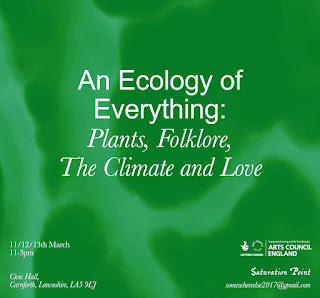An Ecology of Everything: Plants, Folklore, The Climate and Love
Winter was an interior time of quiet industry. All of the dyed samples were cut precisely into strips measuring 12.5mm x 70mm - the measurements were provided by Martin Lord and calculated according to the limited amount of material and the distribution of certain colours based on the regularity of their appearance within the graph. It was more complicated than I expected and a few days were spent cutting and organizing the strips into categories.
Creating a graph reflecting weather data required concentration as I had to follow the weave of the hessian. In total the rag rug took approximately 45 5-6 hour days to produce and involved a disciplined approach to making that I'm less familiar with. I found the process meditative and it allowed me time to listen to some interesting podcasts concerned with ecology and art, Farmerama, Sophie Strand and The Rewilding Series for example.
This is super
natural territory - a wild space of abandonment and industrial retreat – it’s a
fertile island, with edges of impenetrable scrub, entanglements of bramble,
bracken, blackthorn and bog ring fenced by agri-culture and infra-structure. Within
its boundaries and left alone matter has quickly re-aligned, settling in
mycelium-like – earth’s organisms’ quietly massing, seeking attachment, expansion,
fruition with relentless creative energy.
We’re drawn here
too, tracking a yearning to connect with what’s left of the natural – our feral
roots – trampling over civilized myths as we pass the gate stile and open our hearts
to the wood’s aliveness. We cross a threshold and enter a place as exotic as
the past, a shadowy interior of moist air dense with the smell of life, decay,
and millions of fungal spores.
Absorb me.
We follow a trail
to a corridor of pine trees where dead brown needles deaden sound. As we walk, we
sense a communion - every thing we see touches the back of our eye, sound waves
touch ear drum, moss-soaked stone touches skin. Noticing becomes being noticed.
Wetness flows
to the tarn in a clearing – a gouged basin edged with sedges, reeds, rushes, marsh
marigolds and watermint in spring. Philosopher Gaston Bachelard said ‘water
transforms our mirror image into nature’[1]so we
dissolve as we wade into the cold water in our minds. We forage for leaves for
tea: pine needles, cleavers, meadowsweet, wild strawberry, blackberry, and
drink in the present. We’re surprised at how nourished we feel. There’s magic
here - a visceral, tribal thrum as we whisper to jelly ears and weave juncus spirals.
We’ve
witnessed the seasons pass; storms that altered the lie of the land, trunks tumbling
like skittles and mists from the moors and winds that swept in off the bay, ripping
the clouds to let the blue through and a wave of heat that lasted until autumn.
Time briefly tethered we watched the fugitive palette of the landscape shift from
greys to browns to greens to reds and every possible version in-between. A year
in the life of the woods when everything was changing.
Biologist Andreas
Weber says ‘the world is not an aggregation of things, but rather a symphony of
relationships between participants altered by interaction: a necessarily erotic
occurrence’[2].
You, me, the woods, life, matter, every atom part of an inter-connected ecology
of love – the potentiality of being
rippling out into the universe.
[2] Andreas Weber, Matter and Desire, 2014





Comments
Post a Comment